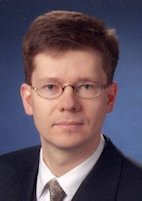
Elektronic Structure and Dynamic of Condensed Matter
A major goal of modern solid-state physics is to achieve the most fundamental understanding possible of condensed matter at the atomic scale. Progress towards this goal is crucial for semiconductor technology, for example. For example, further miniaturization of structures for nanotechnology can only be successful if we know how individual atoms interact with each other on the nanometer scale, adopting optimal bonding configurations at surfaces and interfaces. Due to altered bonding environments, electrons, for example, can behave quite differently at surfaces than in bulk crystals and assume characteristically novel states. The physical description of surfaces and nanostructures requires the application of the fundamental laws of quantum mechanics and quantum statistics. The resulting necessary calculations are based on first principles and are carried out in the framework of the so-called ab-initio theory. Due to the complexity of the systems under study, this requires sophisticated and clever methods as well as powerful computer programs.
On the one hand, the working group is involved in the development of such methods. On the other hand, it applies the developed formalisms numerically to calculate the structural, electronic, optical, vibronic and magnetic properties of solids and their surfaces. The results of such work are used, among other things, for the quantitative interpretation of data from high-resolution experimental surface investigations, such as direct and inverted photoemission or scanning tunneling microscopy. Current topics of the group include the microscopic theory of pure and adsorbate-covered semiconductor surfaces, the calculation of the magnetic properties of metal films on semiconductor surfaces, the simulation of scanning tunneling microscopy images, the ab-initio study of the ballistic transport of electrons in metal-semiconductor hybrid systems, and the calculation of the optical properties of solids in the framework of many-body perturbation theory. Other work deals with the determination of the electronic spectrum of systems with strong spin-orbit interaction. In particular, these include dimensionally reduced solids with a large Rashba splitting of the electronic states and topological insulators.
News
-
Germanistin und Physiker der Universität Münster neu im Jungen Kolleg | WWU News (12.12.2022) |
-
The Physics Student Council’s Teaching Prize: Laureate 2019 | Student Council (24.07.2019) |
- Personalien im Monat Februar 2019 | WWU News (01.03.2019) |
- Physik zur Mittagszeit / Physiker der WWU laden zu öffentlicher Ringvorlesung ein | WWU News (16.04.2018) |
- CRC 1083 Workshop Münster (14./15.06.2018) - Structure and Dynamics of Internal Interfaces / TMDC materials | website |
- Rektorat zeichnet "summa-cum-laude"-Promovenden aus | WWU News (01.12.2017) |
- Infineon promotion prize for physicist Dr. Matthias Drüppel | WWU News | Personalien (07/2017) |
- Infineon promotion prize for physicist Dr. Thorsten Deilmann | WWU News | Personalien (08/2016) |
- Research group presents new study | WWU News |
- The physics student council's teaching prize: Laureate 2015 | Student Council |

